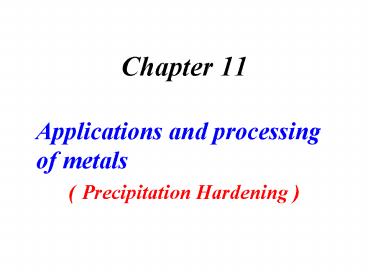Applications and processing of metals
1 / 18
Title: Applications and processing of metals
1
Chapter 11
- Applications and processing of metals
- ( Precipitation Hardening )
2
Types of metal alloys
- Groups of metal alloys
- Ferrous alloy (iron is the prime constituent).
- Nonferrous alloys.
- Steels Iron-carbon alloys that may contain
appreciable concentrations of other alloying
elements. Carbon content is normally less than
1.0 wt. - Cast irons Ferrous alloys with carbon contents
above 2.14 wt (usually 3.0-4.5 wt C).
3
Taxonomy of Metals
4
Classification for various ferrous alloys
5
Steels
6
Nonferrous alloys
7
(No Transcript)
8
Thermal processing of metals
Annealing Heat to Tanneal, then cool slowly.
9
(No Transcript)
10
Precipitation hardening of metals(Heat treatment)
- Strength and hardness of some metal alloys may be
enhanced by the formation of extremely small
uniformly dispersed particles of a second phase
within the original phase matrix. - This strengthening is accomplished by phase
transformations induced by heat treatment. - Age hardness is also used to designate the
process since strength develops with time, or as
the alloy ages.
11
Precipitation hardening (Cont.)
- Requisite features of phase diagrams of alloy
systems for precipitation hardening - Appreciable maximum solubility of one component
in the other (on the order of several percent). - Solubility limit that rapidly decreases in
concentration of the major component with
temperature reduction. - Composition of precipitation-hardenable alloy
must be less than the maximum solubility.
12
Precipitation hardening
Particles impede dislocations. Ex Al-Cu
system Procedure --Pt A solution heat
treat (get a solid solution) --Pt B
quench to room temp. --Pt C reheat to
nucleate small q crystals within a
crystals. Other precipitation systems
Cu-Be Cu-Sn Mg-Al
13
Precipitation hardening (Cont.)
- Types of precipitation hardening process
- Solution heat treatment
- Precipitation heat treatment.
14
Temperature vs. time plot showing both solution
and precipitation heat treatment for
precipitation hardening.
15
Precipitation hardening (Cont.)
- Solution heat treatment
- Quenching (rapid cooling) prevent diffusion and
the formation of a new phase. Resulting phase
will be supersaturated in B atoms (alloy
relatively soft and weak). ? Phase is retained
at room temperature for relatively long periods
(long diffusion rate at room temperature). - Precipitation heat treatment
- The characteristics of the ? phase and the
strength and hardness of the alloy depends on the
precipitation temperature T2 and the aging time
at this temperature.
16
Precipitation effect on TS, EL
2014 Al Alloy
TS peaks with precipitation time.
Increasing T accelerates process.
EL reaches minimum with precipitation time.
17
Effect of aging on dislocation motion
Peak-aged --avg. particle size 64b
--closer spaced particles efficiently stop
dislocations.
Over-aged --avg. particle size 361b
--more widely spaced particles not as
effective.
18
SUMMARY
Steels increase TS, Hardness (and cost) by
adding --C (low alloy steels) --Cr, V,
Ni, Mo, W (high alloy steels) --ductility
usually decreases w/additions. Non-ferrous
--Cu, Al, Ti, Mg, Refractory, and noble
metals. Hardenability --increases with
alloy content. Precipitation hardening
--effective means to increase strength in
Al, Cu, and Mg alloys.































